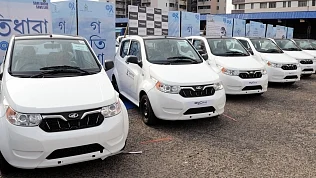In a bid to keep old polluting vehicles off the road, Union Minister Nitin Gadkari announced a new vehicle scrappage policy in the Parliament on 19 March – a move that is likely to boost demand for electric vehicles (EV) in India.
Proposals like the National Electric Mobility Mission 2020, Faster Adoption and Manufacturing of Electric Vehicles in India (FAME-II) scheme have also been launched in a bid to promote usage of EVs in the country.
WHY ARE ELECTRIC VEHICLES GETTING POPULAR?
The most widely praised benefit of an electric vehicle is that it ‘reduces air pollution’. Add to it, incentives proposed in due course from manufacturing to buying of the EV have seen a positive response so far.
Sharing his thoughts on the same, Karan Shah, Executive Director, Precision Camshafts Limited & EMOSS BV told The Quint, “ The new vehicle scrappage policy will be definitely helpful for the uptake of passenger and commercial vehicles with the traditional IC engines as older vehicles would be scrapped. While this would not really help in uptake of electric vehicles immediately, the positive impacts for EVs would be a long-term goal”.
“The commercial vehicles used in India today contribute largely to the pollution and are also prone to much more wear and tear. Electrification of such heavier vehicles would make sense in the short term”, he added.
“The policy will allow Indian customers to churn out vehicles more often, upgrade to new vehicles while reducing the total cost of ownership (TCO). EVs in the country will see more adoption as the policy does favour EVs in multiple ways,” Sandeep Aggarwal Founder & CEO, Droom told The Quint.
The electric vehicle market in India has gained immersive traction in recent years, particularly with the government’s EV-friendly policies aimed at making automobiles more eco-friendly.
HOW BIG IS THE ELECTRIC VEHICLE INDUSTRY IN INDIA?
Electric vehicle industry is growing on the account of the declining prices of EV and the increase in adoption, driven by the rising environmental concerns and the introduction of new vehicle scrappage policy.
According to a market research study by P&S intelligence, the EV market which was worth $536.1 million in 2019, is projected to expand at a robust 22.1 percent during 2020 to 2030.
A survey conducted by CEEW, reveals that EVs were familiar to 87 percent of respondents. After a briefing on electric vehicles for those who were unfamiliar, 71 percent said they would purchase one. While 93 percent of those polled praised the government's efforts to raise awareness and encourage people to switch to electric engines.
WHAT’S THE UPSIDE AND DOWNSIDE OF ELECTRIC VEHICLES?
Electronic vehicles offer a wide range of benefits starting from low maintenance cost to low running cost.
“EVs offer a wide range of benefits for us as well as the environment. They are eco-friendly as they don’t leave a high carbon footprint as compared to petrol or diesel vehicles. EVs also reduce dependencies on oil imports and save fuel costs for vehicle owners. Since the government has introduced several EV-friendly policies and tax reductions on EVs, they come at a lower cost of ownership,” said Aggarwal.
While there is huge scope for electric vehicles in India, what the country lacks is charging infrastructure.
“To produce EVs at a large scale, India lacks robust infrastructure, capital expenditure, and the mindset. Since EVs are a fairly new introduction in the country’s automobile market, there are also factors such as traffic conditions and interstate travel that must be taken into account,”said Aggarwal.
The chance of losing power before finding a source to recharge has caused reservations among potential buyers.
“It is a work in progress but the speed of the transition needs to increase for greater EV demands. Secondarily, we need to be hands-on with repair and maintenance services,” said Shah, flagging concerns over lack of charging infrastructure.
“ Another major hurdle is the technophobia – the end customers, fleet owners, and operators are typically averse to the underlying technology risk that exists with e-vehicles in India, given that it is a very nascent market. In addition, there is certain lack of awareness about the benefits of electric vehicles especially on the commercial vehicle front. Ofcourse, e-vehicles are significantly more expensive at this point and while there can be a payback on the upfront capex within 5 years, there is hesitation from end users to switch at this point”, he added.
IS INDIA READY TO BE A MARKET PLAYER – WHAT’S THE BOTTOMLINE?
India is home to more than 500,000 electric vehicles, including private cars, public transport, buses, two wheelers and three wheelers. However, industry experts believe that India has a lot more to achieve.
Aggarwal believes that to become an e-automobile market, India has a long way to go. “Since the cost of capital in India is inflated, and unlike the USA, Western Europe, or Japan, India is a low trust market, posing two major challenges that automobile players need to overcome. It will take a long time to have properly installed bases for infrastructure. Besides, safekeeping of charging stations can also be a challenge. That said, it isn’t an impossible feat to achieve, just one that will take longer”.
Speaking about the issues in adoption of EV, Nishchal Chaudhary, Founder of BattRe told The Quint, “Where we lack is in the product being all made/produced in India. This is where we fall behind as once the whole EV supply chain can exist without any imports, the overall cost to the customer would reduce and be more pocket friendly. As a result, we’ll witness a higher number of sales”.
(At The Quint, we question everything. Play an active role in shaping our journalism by becoming a member today.)
